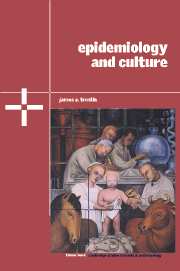Book contents
- Frontmatter
- Contents
- List of Figures and Tables
- Foreword by S. Leonard Syme
- Acknowledgments
- Epidemiology and Culture
- 1 Introduction
- 2 The Origins of an Integrated Approach in Anthropology and Epidemiology
- 3 Disease Patterns and Assumptions: Unpacking Variables
- 4 Cultural Issues in Measurement and Bias
- 5 Anthropological Contributions to the Study of Cholera
- 6 Anthropological and Epidemiological Collaboration to Help Communities Become Healthier
- 7 Perceiving and Representing Risk
- 8 Conclusion
- References
- Index
- References
7 - Perceiving and Representing Risk
Published online by Cambridge University Press: 05 June 2012
- Frontmatter
- Contents
- List of Figures and Tables
- Foreword by S. Leonard Syme
- Acknowledgments
- Epidemiology and Culture
- 1 Introduction
- 2 The Origins of an Integrated Approach in Anthropology and Epidemiology
- 3 Disease Patterns and Assumptions: Unpacking Variables
- 4 Cultural Issues in Measurement and Bias
- 5 Anthropological Contributions to the Study of Cholera
- 6 Anthropological and Epidemiological Collaboration to Help Communities Become Healthier
- 7 Perceiving and Representing Risk
- 8 Conclusion
- References
- Index
- References
Summary
Epidemiologists came under increasingly critical public scrutiny in the 1990s. In 1993 the Lancet published an editorial with the provocative heading “Do epidemiologists cause epidemics?” It inquired whether epidemiologists were making too many errors in their calculations of disease burden and causation, and whether the public was placing excessive confidence in – and deriving excessive anxiety from – epidemiological results. A 1995 news report in the journal Science, titled “Epidemiology faces its limits,” began with this devastating sentence: “The news about health risks comes thick and fast these days, and it seems almost constitutionally contradictory” (Taubes 1995:164). As the cartoon in Figure 7.1 makes clear, epidemiology has increasing presence in the mass media, but its recommendations for how to maintain health and avoid disease seem arbitrary and subject to rapid change. Yet people seek more information about risk even if they do not quite know what it is.
Epidemiology has, until recently, been an accepted source of evidence in many countries about how to identify and reduce disease risk. But that disciplinary authority is increasingly contested by representatives of private industry, government, and the public, who struggle to establish their own definitions of risk and rational solutions to the problem of risk. Because their messages are no longer broadcast only within the profession, epidemiologists' growing engagement in public affairs raises the stakes for the discipline.
- Type
- Chapter
- Information
- Epidemiology and Culture , pp. 150 - 167Publisher: Cambridge University PressPrint publication year: 2005



